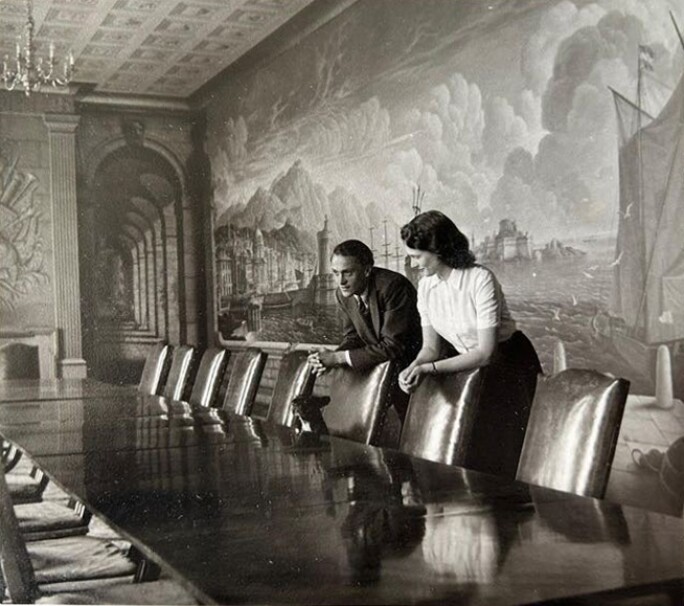A s a small boy running around the huge house, Plas Newydd, where I grew up in the days before it was given to the National Trust, I picked up snippets of my family's history. In the damp and scary basement, there were magnificent uniforms from the Napoleonic Wars and piles of rusty swords and guns. There was also the wooden leg of my ancestor, the 1st Marquess of Anglesey, who was second in command to the Duke of Wellington at Waterloo and had his leg smashed during the battle. You moved the top part of the leg and the toe wiggled. I was told it was the first artificial leg ever that was 'articulated'; before then, it had been all Long John Silver peg legs.

Sharing one of the vast baths on the upstairs ‘nursery’ floor with a sibling, we would giggle at the pictures on the wall – hand-tinted photographs of the eccentric 5th Marquess, known to us as ‘Mad Ux’, cross-dressed as Boudica, yet still sporting the drooping moustaches of an Edwardian aristocrat. In the vast blue-carpeted downstairs sitting room, called the Saloon, we'd be allowed at tea-time to play games and listen to stories read aloud or to music played on 78rpm records. (This was pre-telly. Upstairs, in the nursery we got one in the late 1950s. Dad used to come to the nursery to watch programmes like The Lone Ranger, but we only finally had a TV downstairs in the adult area for the World Cup in 1966.)
I had pointed out to me the picture above the fireplace, of Lord Alfred Paget riding with Queen Victoria in Windsor Great Park. While he smoked one of his Havana cigars, my father told the story of how Lord George Paget had apparently lit up a similar one at the start of the Charge of the Light Brigade and was still puffing away when he returned alive from the ‘Valley of Death’. It proved how quickly that battle was over - and how brave and lucky the Pagets were.

We would have Christmas lunch in the Rex Whistler dining room, with magnificent centrepieces of silver cups, horsemen and candelabra, and – of more interest to us children – silver sixpences hidden in the Christmas pudding. We saw traces of the recent generations of the family dotted around the huge and extraordinary Rex Whistler mural – my grandfather, the 6th Marquess, as an equestrian statue; my father as a small boy pictured twice, stealing apples and peeing against a wall.

The presence of my glamorous and badly behaved aunt Caroline was also much in evidence, as Rex's muse and model for his paintings and in real life. She lived just over the waters of the Menai Strait at Vaynol – when she was not in Chelsea or Tangiers.

She entertained in an aura of exotic perfume (Mitsouko by Guerlain), cigarette holders, Princess Margaret – in stories or sometimes actually, cocktails and decadence. The Vaynol boat house was just across the water, opposite the lawn that ran down from the house to the family flagpole and the cannons – fired only to celebrate the birth of children, in the spirit of those sexist times, more times for a boy than a girl. Caroline and my father would have shouted conversations between the island of Anglesey and the mainland.

Other glimpses of family history came on ‘mystery tours’, being driven around Anglesey by my father. When we passed the statue of ‘One Leg’, the 1st Marquess, standing on top of his column next to the Britannia Bridge, we always waved to our ‘great-great-great-grandfather’. There was usually some confusion and discussion about the number of ‘greats’. We visited the strange orange moon-like landscape of the Parys Mountain mines which, part-owned by the family, had in the 1780s been the largest copper mine in Europe.

More recent family history was illustrated by my father slamming on the brakes as we were bowling down tiny Anglesey lanes, shouting ‘Germans ahead’ and reversing at breakneck speed between the hedgerows. In the Second World War, he had driven armoured cars to reconnoitre ahead of the Allied lines as they advanced up Italy and so reversing at speed, once the enemy was spotted, was one of the skills he had learnt.

How had the family history begun? In the ‘Gothick Hall’ at Plas Newydd, beneath horrific pictures of dead birds and hounds tearing apart a bear, were three imposing and almost identical portraits of Lord William Paget; he looked very severe and had a weird forked beard. I was told he had been an important Tudor statesman and was the founder of the family's fame and fortune.

I had been slightly curious as a boy about what was evidently an interesting family history, but I pretty much ignored it whilst my adult life took other directions. I left home physically and mentally: I did a PhD at the University of Sussex; thought I was a Maoist, worked for a publisher of illustrated books on subjects such as gardening and childbirth; with a partner founded and ran a successful small business; went to art school aged 40; and later pursued my passion for painting in a semi-professional way.

It was only when my father died, when I got involved with the National Trust’s ‘telling the family story’ and started to look through the amazing collections of archives in the basement at Plas Newydd and elsewhere, that my interest was rekindled…
Extracted by kind permission from the foreword of ‘The Great Survivor of the Tudor Age, The Life and Times of Lord William Paget’, Pen and Sword Books, 2023.

